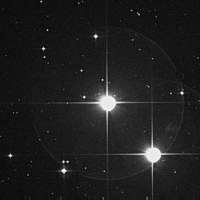Please
Note:
This report was originally published in "Focus" magazine edited by Bill Moore,1991.
REPORTER:
"And what planet
do the EBENS "aliens" come from?"
INTELLIGENCE SOURCE CODENAMED
"FALCON" (Rick Doty in this case): "(From) the Zeta Reticuli star group ... (there are) two
suns together."
Q:
"And is this the primary
source of the alien visitors here?"
A:
"Ahh, to the best of my
knowledge, yes."
Q:
"How long
does the trip from Zeta Reticuli take....?"
A:
"They
can... do it in about 91 days."
Q:
"How big is
their home planet?"
A:
"(The)
EBEN'S planet is similar to Earth, but the air is a bit thinner and contains a higher
proportion of Argon and Helium. Also, the average temperature is a bit cooler
especially in the northern part of their planet.
They like our high mountain regions where the air is thinner and the temperature is
cooler. They can't stand a lot of heat.
Q:
"Now, can
we get into describing the physical conditions and characteristics of the aliens?"
A:
"(They are)
creature(s) about 3'4" to 3'8" tall. Their eyes are extremely large, almost
insect style (with) a couple of different inner lids....Their skin structure is extremely
ahhh... it's a very elastic skin, and hard. Probably hardened from their sun."
The above was excerpted from interviews conducted with U.S. intelligence agent codenamed "Falcon" in March, 1984 and
February, 1987.
Evidence gleaned from both the Betty and Barney Hill abduction case and from intelligence sources (including "Falcon", above) has suggested that the home of at least one group of supposed alien 'visitors" to Earth may well be the Zeta Reticuli system. They are a pair of companion stars (two stars traveling together in the same direction at the same speed as a wide-binary system) located some 39.4 to 39.5 light-years distant.
**For
a reported team of United States Military volunteers from 1965 to 1978 under a project named
SERPO see, Rick
Doty discusses SERPO
(pdf).
See book review below for the problems.
Serpo,
did it really happen?

The prime source of information about these stars is L. DaSilva and R. Foy's paper "Zeta 1 and Zeta 2 Reticuli: A Puzzling Solar-Type Twin System", which can be found in Astronomy and Astrophysics (177, 204-216 <1987>). See,
L.
DaSilva and R. Foy.
The two stars, Zeta 1 and Zeta 2, are located in the southern
constellation of Reticulum (the net) and are thus never visible to most of the northern
hemisphere. Both are classed as old disk population II stars whose age is between six to
eight billion years. There is every indication that both had a common origin and are part
of a relatively near-by old moving group (or loose cluster) of stars which was first
defined in 1958 and is known as the Zeta Hercules group. Zeta 1 Reticuli is separated from Zeta 2 Reticuli by at least
367 billion miles
or about 100 times the Sun-Pluto distance. They may be even farther apart but,
as just mentioned above, the available observations suggest they are moving through space together and are therefore physically associated. They probably require at least
a 100,000 years to orbit around their common center of gravity.
Our own Sun has an estimated age of only five billion years
and is classed spectroscopically as a G-0 star (yellow-orange dwarf). Zeta 1 and Zeta 2
are classed as G-2 and G-1 respectively, with luminosities ("L") of
0.8 and 1.02 (the Sun being L=l.O). This means that both Zeta 1 and Zeta 2 are very Sun-like and could
well possess solar systems much like our own.
In their highly technical paper, DaSilva and Foy offer two
very important conclusions about these stars which radically contradict earlier findings.
These are that neither star is metal-deficient and that neither is a close binary (or
double). Earlier evidence (published by Bonneau et al., 1980) identifying Zeta 2 as a very
close binary turns out to have been mistaken (Bonneau and Foy, 1986).
The puzzling aspects of these "close" stars
(One tenth of a light year apart) center around discoveries of higher than expected gravity and
ultraviolet output when compared to their apparently normal metal content (i.e. not
metal-poor). The ultraviolet excess and kinematic (proper motion and orbit) data suggest
that these two stars belong to the old population II stars as mentioned earlier; yet the
apparent high gravity figure seems more typical of an unevolved, metal-poor condition.
Since DaSilva and Foy's work resulted in strong confirmation of a Sun-like (or
"normal") metal content for these stars, they began to look elsewhere for an
explanation of the gravity paradox. The answer came with the discovery of an apparent
overabundance of helium (twice as much as our own Sun) in the stellar photospheres. This,
when worked into the calculations, not only explained the high gravity, but also accounted
for the observed problem of the stars' high ultraviolet output but relatively low overall
luminosity. Another effect of the helium abundance would be to slow the process of stellar
evolution across the main sequence.
Additionally, it should be noted that Zeta 1 was one of the
first stars ever to be used as a solar analog by astronomers. What might these findings
signify as far as Zeta 1 and/or Zeta 2 possessing planets with advanced intelligent life?
Let's make a list of the strong points which support this idea:
(1) Both Zeta 1 and Zeta 2 are
solar, or Sun-like stars. (If one imagines a spherical section of our galaxy with a radius
of 50 light years and centered upon our Sun, only one star out of every eleven contained
therein will have Sun-like characteristics.)
(2) The previous objection that
one and perhaps both stars appeared to be close binaries has now been swept away. Stable
planetary orbits in the so-called eco-zone (i.e. close enough to the central fire to
produce conditions conducive to life) are more probable around single stars than in
close binary
systems.
(3) Both Zeta 1 and Zeta 2 have
an average age of between six and eight billion years. This makes them from one to three
billion years older than our Sun and suggests that any life on planets associated with
them could be much further along in its evolutionary process than we are.
(4) In many reported UFO
abduction cases, the "visitors" have been described as having a thick epidermis
and multiple eyelids. This is precisely the sort of adaptation one would expect for
creatures who evolved on a planet whose sun had a high ultraviolet output. Curiously
enough, these characteristics were also reported by the intelligence source codenamed
"Falcon" as early as 1981.
On the negative side, it must be admitted that there is no
direct observational evidence of planets around either Zeta 1 or Zeta 2. However, a
Canadian group reported that a Jupiter-sized planet appears to exist in orbit around Tau
Ceti, a Sun-like star only about 11 light years away. Those readers familiar with the star
map developed by Marjorie Fish based upon information from the Barney and Betty Hill UFO
abduction case, will recall that Tau Ceti was identified as one of the stars on that map.
Since the original 1991 publication of this report tremendous
strides have been made in the discovery of possible new solar systems and the detection of
planets around other stars: With each passing day there is more and more data that appears
to strengthen the idea that solar systems are quite common and very abundant.
For
current efforts to find planets around Zeta1 and Zeta2 please see The
Anglo-Australian Planet Search. Both Zeta1(HD20766) and Zeta2
(HD20807)
are on their planet search list. Thanks to Dr Chris Tinney for this
information who is/was the head astronomer at the Anglo-Australian Observatory.
In the below report Livio maintains that carbon
production didn't peak until about 2 billion years before the sun-earth were formed and
that advanced type intelligent life didn't emerge on Earth until ~ 4 million years ago: Of
course assuming estimate errors (perhaps large) this more than leaves room for the Zeta
Reticuli Star System with a current estimated age of ~ 7 billion years: Or, the Zeta
Reticuli Star System was in the formation process when this carbon production peaked
according to Livio. See, Extraterrestrial Civilizations: Coming of Age in the Milky Way
